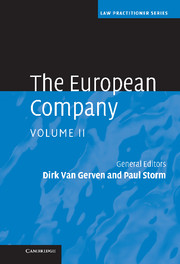6 - Ireland
from Part II - Application in each Member State
Published online by Cambridge University Press: 06 July 2010
Summary
Introduction
1. The Regulation has been implemented in Ireland partly by means of two new statutory instruments, the European Communities (European Public Limited-Liability Company) Regulations 2007 (the ‘ECR1’) and the European Communities (European Public Limited-Liability Company) (Forms) Regulations 2007 (the ‘ECR2’) together (the ‘ECRs’). This legislation was issued on 31 January 2007. ECR1 and ECR2 deal with the company law aspects of SEs. The ECRs are supplemented by the legal provisions applicable to public limited companies, found mainly in the Companies Acts 1963–2006 (the ‘CA’) and the common law.
The Directive has also been implemented in Ireland by means of a statutory instrument, the European Communities (European Public Limited-Liability Company) (Employee Involvement) Regulations 2006 (the ‘EEIR’).
In drawing up the ECRs, the legislature adopted a minimalist approach and drafted the legislation in such a manner so as to avoid significant conflicts with existing domestic company law.
This report focuses on implementation of the Regulation and transposition of the Directive in Ireland, and in particular on the options provided in the Regulation which Ireland has chosen to adopt. Any reference in this chapter to ‘Ireland’ or the ‘State’ refers to the Republic of Ireland.
Formation
General remarks
Founding parties
2. Article 2(1) to (4) of the Regulation lists the legal entities that can participate in the formation of an SE.
- Type
- Chapter
- Information
- The European Company , pp. 174 - 202Publisher: Cambridge University PressPrint publication year: 2008

